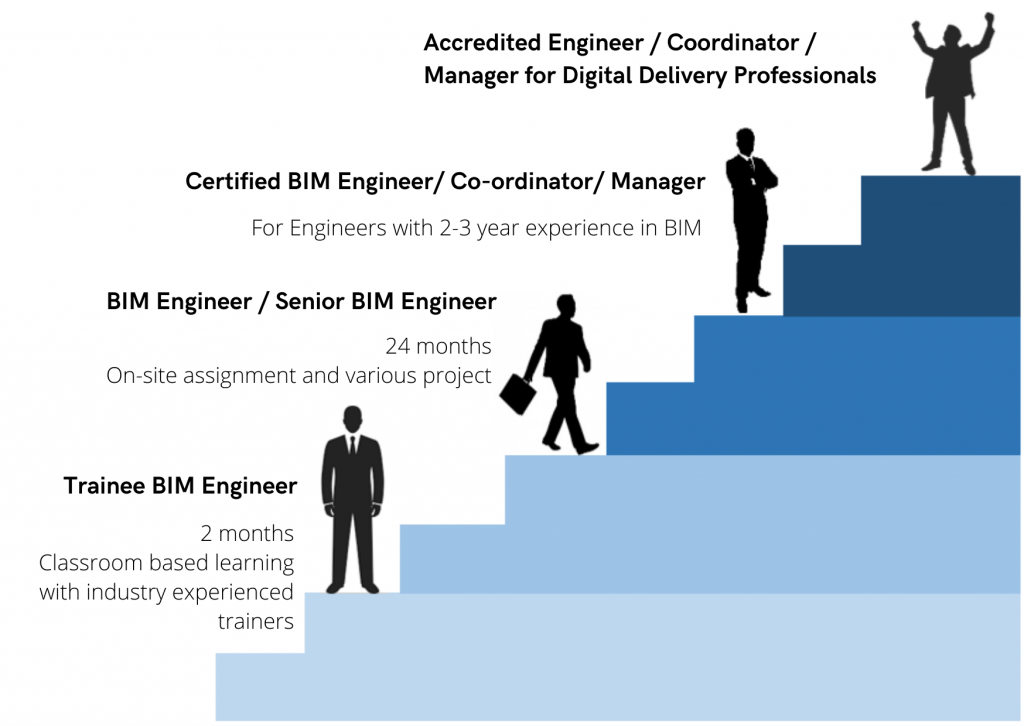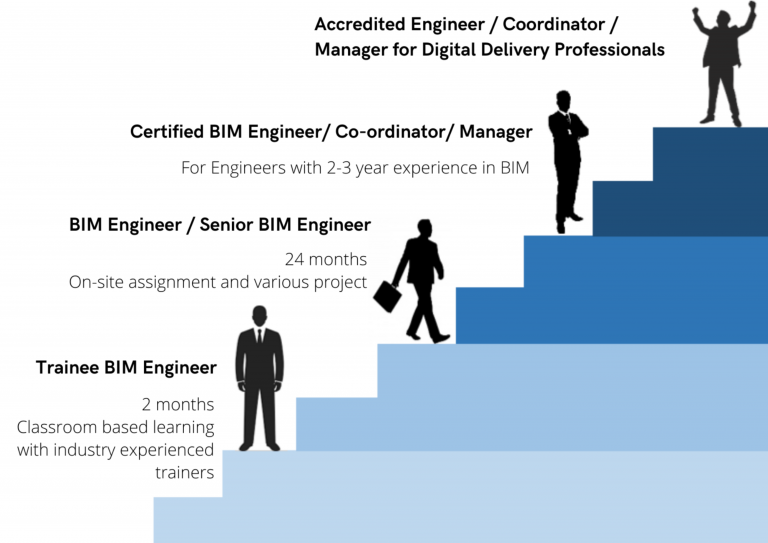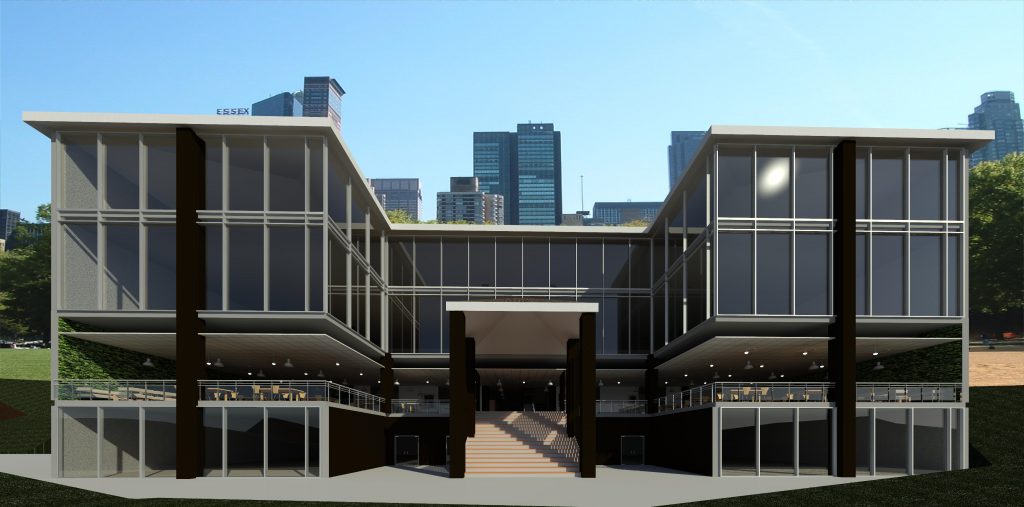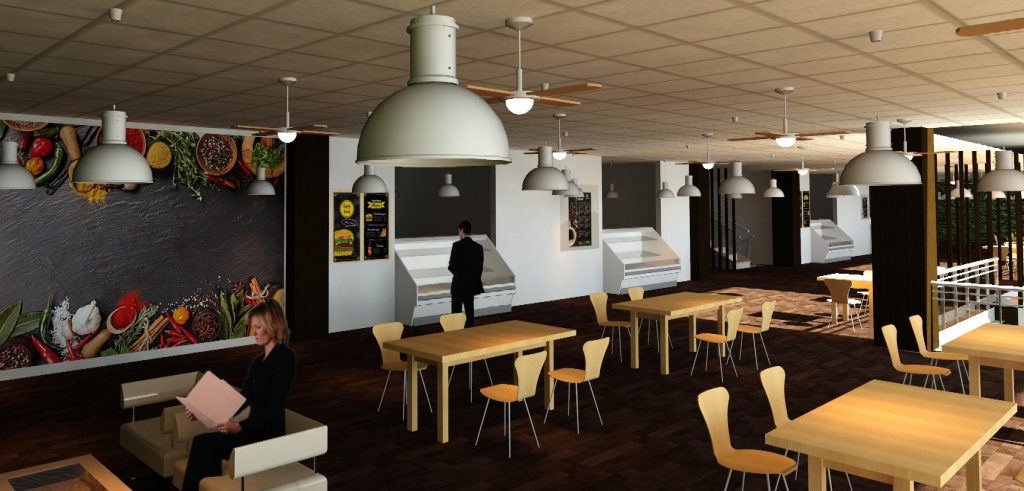In the 26-month AcePLP Career Advancement Programme, you start off in our classrooms to undergo intense technical training in BIM to build your foundational skills in Digital Delivery Management. This prepares you for your career in BIM, as well as jobs in Virtual Design and Construction and Integrated Digital Delivery.
Through our training programme, we ensure that you gain the ability to use the most popularly used BIM application software in Singapore, which are Autodesk Revit, Bentley OpenBuilding, OpenRail and OpenPlant. This gives you the flexibility to work on various kinds of building and infrastructure projects in Singapore. We will also cover the use of 2D products such as AutoCAD and MicroStation, which are crucial for the documentation of the BIM models.
As and when the use cases arise, we will put you through training in 4D BIM products, combining the BIM model with a Microsoft Projects or Primavera P6 schedule using products such as Synchro 4D or Navisworks Manage, enabling you to deliver on jobs in Virtual Design and Construction processes. You may undergo other types of training depending on your interest and where the opportunities take you.


BIM Fundamentals and Principles
BIM Fundamentals and Principles:
Building Information Modeling (BIM) revolutionizes the way construction projects are planned, designed, constructed, and managed. It’s a digital representation of the physical and functional characteristics of places. Here’s a breakdown of its fundamentals and principles:
Definition of BIM:
BIM is a process supported by various tools, technologies, and contracts involving the generation and management of digital representations of physical and functional characteristics of places. These representations, often referred to as BIM models, offer insights and tools for efficient decision-making throughout the project lifecycle.
Evolution of BIM:
BIM has evolved from traditional 2D drafting methods to a multi-dimensional approach. Initially, BIM started with 3D modeling but has expanded to include additional dimensions such as time (4D), cost (5D), sustainability (6D), and facility management (7D). This evolution enables stakeholders to consider various aspects of a project comprehensively.
Core Principles of BIM:
Collaboration: BIM facilitates collaboration among various stakeholders involved in the construction project, including architects, engineers, contractors, and facility managers. By providing a common platform for sharing information, BIM enhances communication and coordination, leading to smoother project workflows.
Visualization: Unlike traditional 2D drawings, BIM offers three-dimensional visualization, allowing stakeholders to better understand spatial relationships and design intent. This improves communication and helps identify potential clashes or conflicts early in the design process.
Information Management: BIM centralizes project information, including geometry, spatial relationships, geographic information, quantities, and properties of building components. This comprehensive data repository enables better decision-making throughout the project lifecycle and supports tasks such as cost estimation, scheduling, and facility management.
Accuracy and Efficiency: BIM enhances the accuracy of project information by reducing errors and omissions commonly associated with traditional drafting methods. Additionally, it streamlines workflows, automates repetitive tasks, and improves productivity, leading to cost and time savings.
Lifecycle Perspective: BIM extends beyond the design and construction phases to encompass the entire lifecycle of a building, from inception to demolition. This holistic approach enables stakeholders to consider factors such as maintenance, operation, and renovation, optimizing the building’s performance over time.
By adhering to these core principles, BIM transforms the construction industry by improving efficiency, reducing costs, minimizing errors, and enhancing collaboration throughout the project lifecycle.
Entry Requirements

Role of Graduates In BIM at AcePLP
Fresh BIM graduates and mid-careerists with no prior work experience will complete 2 months of classroom training in BIM and CAD applications. The training is conducted by Ace Industry Academy (AIA), the official training arm of AcePLP, and will prepare you as you embark on your career as a BIM engineer. AIA is an SSG/WSG approved training provider, and some modules which you attend during this period will be WSQ-accredited, and in line with the national skills framework for the Built Environment. (SSG/WSG is a statutory council formed by the Ministry of Manpower and Ministry of Education.)
Certificates will be awarded on completion of classroom training, and thereafter, you will be assigned to work on projects to gain experience. To guarantee a smooth transition, AcePLP pairs freshly trained BIM Engineers with senior colleagues or Alumni. Trainers will also be on hand to assist the new engineers if they run into any challenges. The experience you gain from participating in projects can be used towards the Digital Delivery Management Accreditation Scheme.
The use of BIM in Digital Delivery Management is one of the most exciting developments in the building and construction industry, and represents exciting job opportunities for fresh graduates in BIM. It has changed the way that Architects, Engineering, Contractors and Building Owners work together on construction projects, greatly increasing the efficiency in processes and enhancing collaboration among teams.
As a BIM Engineer at AcePLP, you will develop your technical skills in creating and coordinating BIM models of the Built Environment and grow your professional network from within. As you provide digital delivery services to our clients on behalf of the AcePLP team, you will gain practical knowledge and experience of the Built Environment through jobs in BIM.
One of the most important things you can learn from this job is to combine your spatial awareness from digitalization and visualization of the Built Environment with improving processes and increasing efficiency using the latest construction technology. You will become very comfortable with reading and interpreting building plans and translating them from a paper-based format into digital replicas of projects, otherwise known as digital twins.
In your projects, you will serve clients that are contractors, consultants, or facility owners and operators. They can be stakeholders anywhere along the building lifecycle, such as planning, design, construction, and facilities management. You may be assigned to work on Architecture, Civil or Mechanical and Electrical type of projects, or a combination of several engineering disciplines.
What You Will Learn On The Job
As a BIM Engineer at AcePLP, you will develop your technical skills in creating and coordinating BIM models of the Built Environment and grow your professional network from within. As you provide digital delivery services to our clients on behalf of the AcePLP team, you will gain practical knowledge and experience of the Built Environment through jobs in BIM.
One of the most important things you can learn from this job is to combine your spatial awareness from digitalization and visualization of the Built Environment with improving processes and increasing efficiency using the latest construction technology. You will become very comfortable with reading and interpreting building plans and translating them from a paper-based format into digital replicas of projects, otherwise known as digital twins.
In your assignments, you will serve clients that are contractors, consultants, or facility owners and operators. They can be stakeholders anywhere along the building lifecycle, such as planning, design, construction, and facilities management. You may be assigned to work on Architecture, Civil or Mechanical and Electrical type of projects, or a combination of several engineering disciplines.
Your ability to coordinate across engineering disciplines and incorporate the latest technological advancements into project processes will set you up for an exciting career in digital delivery.
What Is Your Career Progression As A BIM Modeller?
BIM has greatly improved how architects and engineers design and construct buildings and have now become integral to all processes in the Built Environment. If you have a diploma in BIM, or a degree in BIM, you will have many opportunities in Digital Delivery Management track, so long as your interest lies in technology implementation. Jobs in BIM Digital Delivery involves the adoption and implementation of up-to-date emerging digital technologies to optimize operations and processes, improve collaboration and enhance work efficiency.
Career Pathways Of BIM Graduates To Accredited Digital Delivery Management (BIM) Professionals

Other Available Positions

IT Systems Engineer
Manage our existing network infrastructure and develop IT Solutions for clients to meet their business needs.

Human Resources
Engage with aspiring young engineers and develop policies and initiatives that nurture a learning environment.

Sales
Be part of a team sourcing out the best opportunities for talent development, and help us create valuable networks in the industry.

Production Operator
Collaborate on our print production line and delivery services




